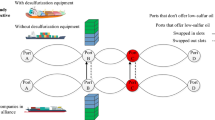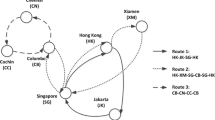Abstract
Bunker fuel costs could account for 50–60 per cent of a ship's total operating cost in times of high fuel prices. The volatility of the bunker market over recent years has contributed to significant instability of cash flows for shipping lines. In this study, we consider two of the bunker fuel risk management measures employed by container shipping companies to reduce bunker fuel price risk – re-planning of network configuration and financial hedging of bunker fuel prices. The current industry practice is that the network planning and bunker hedging functions are carried out separately and sequentially. Specifically, the liner network is first planned to decide the ports of call, routes, fleet size, vessel types, and subsequently bunker hedging is performed based on the projected bunker fuel consumption and the forecast of bunker fuel price. This article shows the interdependencies between network planning and bunker hedging practices. By a numerical example using decision tree analysis, we illustrate the benefits of using an integrated planning approach that combines network planning and bunker hedging over the widely practiced sequential planning approach. We find that the integrated planning allows shipping lines to identify all available planning options and enables them to make decisions that could better meet the company's managerial priorities in terms of cost, transit time and risk.









Similar content being viewed by others
References
AECOM. (2012) NC Maritime Strategy: Vessel Size versus Cost. AECOM in association with URS. North Carolina Maritime Strategy Research Report, http://www.sbeydo.com/maritime/Tech_memo/TM%20Vessel%20Size%20vs%20Cost_FINAL.pdf, accessed 18 December 2012.
Alizadeh, A.H., Kavussanos, M.G. and Menachof, D.A. (2004) Hedging against bunker price fluctuations using petroleum futures contracts: Constant versus time-varying hedge ratios. Applied Economics 36 (12): 1337–1353.
Bartram, S., Brown, G. and Fehle, F. (2009) International evidence on financial derivatives usage. Financial Management 38 (1): 185–206.
Carter, D., Rogers, D. and Simkins, B. (2006) Does hedging affect firm value? Evidence from the U.S. airline industry. Financial Management 35 (1): 53–86.
Chopra, S. and Meindl, P. (2007) Supply Chain Management: Strategy, Planning & Operations. New Jersey: Pearson Prentice Hall.
Cullinane, K. and Khanna, M. (1999) Economies of scale in large containerships. Journal of Transport Economics and Policy 33 (2): 185–208.
Cullinane, K. and Khanna, M. (2000) Economies of scale in large containerships: Optimal size and geographical implications. Journal of Transport Geography 8 (3): 181–195.
El-Masry, A. (2006) Derivatives use and risk management practices of UK non-financial companies. Managerial Finance 32 (2): 137–159.
Fagerholt, K., Laporte, G. and Norstad, I. (2010) Reducing fuel emissions by optimizing speed on shipping routes. Journal of the Operational Research Society 61 (3): 523–529.
Hillier, F.S. and Lieberman, G.J. (2009) Introduction to Operations Research. New York: McGraw-Hill.
Hull, J.C. (2009) Options, Futures and Other Derivatives. New Jersey: Pearson Prentice Hall.
Jin, Y. and Jorion, P. (2006) Firm value and hedging: Evidence from U.S. oil and gas producers. Journal of Finance 61 (2): 893–919.
Kavussanos, M.G. and Visvikis, I.D. (2006) Derivatives and Risk Management in Shipping. London: Witherby Publishing.
Lerner, R.L. (2000) The Mechanics of the Commodity Futures Markets. New Jersey, USA: Mount Lucas Management Corporation. Futures Investment Series Special Report no. 2.
Menachof, D.A. and Dicer, G.N. (2001) Risk management methods for the liner shipping industry: The case of the bunker adjustment factor. Maritime Policy & Management 28 (2): 141–155.
Meng, Q. and Wang, S. (2011) Optimal operating strategy for a long-haul liner service route. European Journal of Operational Research 215 (1): 105–114.
Nguyen, D.B. (2009) Impact of High Fuel Costs on the Shipping Industry and the World Trade, Proceedings of the Cardiff University Conference on the Globalization and its Implications for Shipping in the 21st Century; 22 January, Cardiff, Wales. Cardiff University.
Notteboom, T.E. (2006) The time factor in liner shipping services. Maritime Economics & Logistics 8 (1): 19–39.
Notteboom, T.E. and Cariou, P. (2009) Fuel Surcharge Practices of Container Shipping Lines: Is It About Cost Recovery or Revenue Making, Proceedings of the 2009 International Association of Maritime Economists (IAME) Conference, 24–26 June; Copenhagen, Denmark: International Association of Maritime Economists.
Notteboom, T.E. and Vernimmen, B. (2009) The effect of high fuel costs on liner service configuration in container shipping. Journal of Transport Geography 17 (5): 325–337.
Ronen, D. (1982) The effect of oil price on the optimal speed of ships. Journal of the Operational Research Society 33 (11): 1035–1040.
Ronen, D. (2010) The effect of oil price on containership speed and fleet size. Journal of the Operational Research Society 62 (1): 211–216.
Samitas, A. and Tsakalos, I. (2010) Hedging effectiveness in shipping industry during financial crises. International Journal of Financial Markets and Derivatives 1 (2): 196–212.
Tan, G. (2010) Global economy will suffer more financial crises in next 10 years: Roubini. CNBC, 27 September, http://www.cnbc.com/id/39375262, accessed 18 October 2010.
Vernimmen, B., Dullaert, W. and Engelen, S. (2007) Schedule unreliability in liner shipping: Origins and consequences for the hinterland supply chain. Maritime Economics & Logistics 9 (3): 193–213.
Wang, D.-H., Chen, C.-C. and Lai, C.-S. (2011) The rationale behind and effects of bunker adjustment factors. Journal of Transport Geography 19 (4): 467–474.
Wang, S. and Meng, Q. (2012) Sailing speed optimization for container ships in a liner shipping network. Transportation Research Part E: Logistics and Transportation Review 48 (3): 701–714.
Acknowledgements
The authors wish to thank two anonymous referees and the editor-in-chief for their insightful comments, which have helped in making significant improvements in the article. This article is a result of ongoing research at the Nanyang Technological University, which forms part of the first author's PhD thesis. The first author is supported in the later part of this research by the NOL Fellowship (NOLF) programme, an initiative by Neptune Orient Lines Ltd and the National University of Singapore.
Author information
Authors and Affiliations
Rights and permissions
About this article
Cite this article
Wang, X., Teo, CC. Integrated hedging and network planning for container shipping's bunker fuel management. Marit Econ Logist 15, 172–196 (2013). https://doi.org/10.1057/mel.2013.5
Published:
Issue Date:
DOI: https://doi.org/10.1057/mel.2013.5




